DIY masonry: a detailed guide + orders with diagrams and drawings
The stove is a multifunctional, technically complex construction. Within its limits, fuel is processed, heat is obtained and combustion products are removed to the outside. If you plan to lay the furnace with your own hands, you must strictly observe the rules that have been verified in practice for centuries, guaranteeing the normal operation of the unit.
If you want to know how to perfectly build a brick stove, we will find detailed information on all important issues of interest to an independent master. In the presented article, the technological specifics of the structure are given in the finest details, the main postulates of stove makers and significant nuances are scrupulously listed.
The information we provide will be of great help in the construction of a brick oven. All its components will begin to cope perfectly with the duties, and the construction itself will last for many years without complaints. To help home craftsmen, we have selected ordinal schemes, photo images, video recommendations.
The content of the article:
Structural components of brick ovens
Before proceeding with the construction of the stove, you should decide on its purpose. Heating, cooking and drying units have significant design differences that must be taken into account initially. There is a reasonable difference in the orders developed by the stove for the exact laying of bricks.
There are many furnace designs that can be divided into groups according to purpose:
Country houses, as a rule, not connected to centralized heating systems, are mainly equipped with universal cooking and heating units. The back side of them unfolds in living quarters, the front - in the kitchen. On the front side usually have a hob and main stove appliances.
Suppose that we are interested in exactly the universal option, the construction of which we will carefully deal with. Like everyone else types of stoves, it consists of a foundation, an array, including a firebox with its devices and air ducts, and a chimney.
Foundation: device features
The base on which to install the stove is always built separately from the foundation of the house.
This fact is justified by a number of good reasons:
- The brick structure has an impressive weight, the subsidence of soils under it will be much more than under the walls of the house.
- The linear dimensions of the unit operating in high temperature mode are unstable. Stoves are characterized by some movements, which, in principle, is contraindicated in the walls of the building.
- A separate arrangement of the foundation provides sufficient technological indentation between the furnace and building structures, which ultimately prevents and reduces the likelihood of fire.
In addition, a furnace built on a separate foundation is easier to repair, easier to upgrade and rebuild if necessary.
The foundation of the stove is made of buta or brick, using lime or cement mortar as a connecting composition. In the construction of the base is prohibited the use of clay mixture, because it quickly collapses in constantly moist soils.
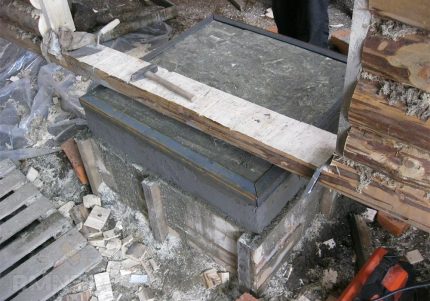
Moreover, the composition of the binder solution is selected depending on the degree of humidity of the underlying rocks. For the construction of the foundation in low-moisture soils, lime or lime-cement mortar is used, in wet soils only cement compositions are used.
In terms of foundation, the foundation should be at least 5 - 7 cm larger than the furnace on each side. The depth of its laying depends on the dimensions of the unit, on average it is 0.75 m. For single-storey dachas, it is permissible to go deep by only 0.5 m. The furnace for a two-story house should stand on a foundation with a capacity of 1.0 m.
There is an article on our website where we examined in detail the process of arranging a brick stove for a summer residence. More details - go to the link.
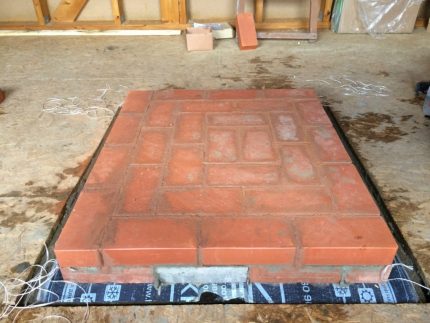
When building a foundation from a buta, it is not brought to the floor level, leaving 14 cm free. This free space is filled with two rows of bricks. The foundation laid to the floor level is covered with two layers of roofing material or roofing felt for waterproofing. Instead of these insulating materials, a 2 cm layer of clay or a cement screed of the same power is often used.
Array of the furnace: the specifics of the structure
The main components of the furnace array are the casing, the firebox and the chimneys. In the masonry of the body and channels that hold the smoke inside the furnace to increase heat transfer, solid red brick is used. Lining, i.e. the inner lining of the furnace is produced by refractory refractory bricks.
The case with smoke is placed on a clay sand mortar. A mixture of fireclay powder with refractory clay is used in the lining. They seek to minimize the thickness of the joints during masonry. The maximum thickness in the masonry of the body and channels is 5 mm, in the lining of the furnace the seams should not exceed 2-3 cm.
We note immediately that the furnace body and the lining cannot be bandaged. These should be two separate structures, as they heat up to different temperature levels and expand, respectively, in different ways.
For laying the furnace, you can buy ready-made fireclay and clay-sand mixtures. True, a solution of clay and sand without any problems can be prepared by yourself. The proportions of clay and sand in such a home-made composition are selected depending on the clay content, the proportions vary in the range from 1: 0 to 1: 3.
An important condition for ensuring the strength of the structure is compliance with the dressing of the seams. This rule will prevent the destruction of the walls. Before masonry work, the red bricks are soaked for 10-15 minutes in a container of water so that they do not "pull" water from the "binder" solution, they simply wipe the refractory ones.
During masonry, an independent stove should:
- Constantly check the horizontal row and check the diagonals. If there is even a slight deviation along the diagonals, this is already a signal for disassembling the upper rows and correcting the error.
- Fill the joints completely with mortar. Regularly wipe the structure from the side with rags and remove excess binder.
- Wipe the inside of the surface of the chimneys with a damp, wet brush. This is required to prevent the formation of roughness.
In order to ideally build a brick stove, as experienced stove-makers do, you must first type each row dry. By examining the position of the bricks without mortar, you can immediately see the errors. In addition, it’s easier to mark and prune.
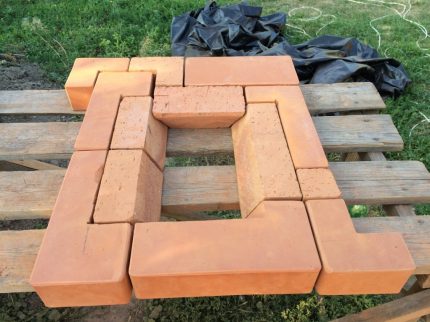
Without a dry layout, it is allowed to lay only straight rows that do not affect structural parts, devices and chimneys.
Pipe: construction options and rules
Smoke channels are laid out of solid red brick.For a bunch of elements within the attic, lime or cement-lime mortar is used. The outer part of the pipe is built exclusively on cement mortar, because clay is easily and quickly washed out by rainwater and dissolved by winter precipitation.
According to the type of arrangement, the pipes of brick stoves are divided into three types, these are:
- Mounted. The smoke channel is a direct continuation of the unit, rises directly above its body with smoke circuits.
- Indigenous. Such a pipe is placed on a separate foundation, with a sleeve connected to the stove laid at the corners.
- Wall. These chimneys are arranged right in the main walls located in the middle of the house.
Small stoves for country houses are built mainly with mounted pipes, they occupy less useful space. The smoke channel must be exactly vertical and clearly maintained in cross-sectional size and height.
At the level of the intersection by the pipe of the wooden floor, they arrange cutting, broadening, covering the opening, but not adjacent to combustible materials. In the gap between the pipe and the ceiling, a tow soaked with clay solution or soft asbestos is laid.
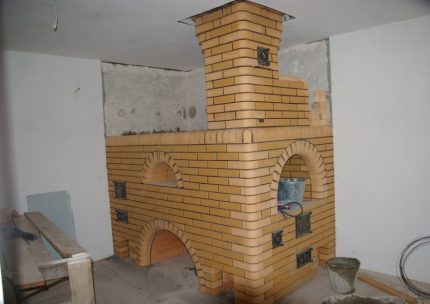
When laying pipes over a brick roof, an otter is formed - a broadening that protects against condensate draining into the channel. Within the attic, the chimney is plastered and whitened so that leaks can be immediately identified by cracks that appear in the whitewash.
A metal pipe is put on the constructed pipe deflector - a metal cap on the legs, protecting from leakage into the channel of atmospheric water. At the same time, this device extinguishes sparks, which is extremely necessary if the roof is made with flexible tiles or ondulin.
The nuances of finishing the stove
The walls of the stove, made of good brick, and even decorated with the outside, do not need to be finished: whiten and plaster. If there are no chips and cracks on the masonry elements, the vertical and horizontal lines were observed during construction, the heating structure will look great.
For stove masonry made of high-quality brick, it is enough to grout and gently embroider the seams. Without extra decoration, the heating and cooking facility looks better.
If there are still claims to the furnace walls, defects are observed on them, and the masonry is imperfect, then the finish is very necessary. Before finishing work, the outer surface is thoroughly scrubbed, rubbed with a piece of brick to improve adhesion, and then wait for it to dry.
The dried unit can be plastered using the clay-sand mortar used in the masonry. To increase the strength, it is possible to add 1% of asbestos chips to the composition. Heating variants of stoves are tiled with tiles - this is the most reliable and gas-tight, but also the most time-consuming type of decoration.
Possible complications for the stove
In a country house constructed according to a typical project, the location of the furnace, the outlet of the chimney, and convenient places for maintenance and operation are usually provided in advance.It is much more difficult to arrange a heating and cooking unit in a house under construction on an individual idea. Even harder if the house is already built.
It so happens that after choosing the location of the stove, which, according to the owner, is good, and even after building the foundation, they suddenly discover that the chimney will cross the floor beam or rafters. What to do in such a situation?
The way out in this case is associated with two difficult and rather expensive options. In the first of them, it will be necessary to sort out the overlap and change the position of the beams and rafter legs, in the second - to destroy and rebuild the foundation of the stove.
In order to eliminate such troubles, before marking and building the foundation in the built house, it should be determined whether the chimney will violate the integrity of existing structures. If there is the possibility and access to the beams not yet sheathed, it is necessary to plumb check the exact position of the components of the marked furnace.
If in a house being built with a do-it-yourself house, it is most convenient to place a brick stove in a place whose projection intersects the elements of the roofing system, it is better to shift them. In general, of all the options, it is advisable to choose the one that will be easier and cheaper to implement.
In the design of the furnace and the selection of a suitable model, the following rules should be considered:
Laying a simplified version of the Russian stove
We will analyze the specifics of building a simplified version of a Russian stove using a specific example. Like all units in this category, it belongs to the cooking and heating equipment, which means it is equipped with a cast iron hob. There are also two fireplaces in it, which allows heating the room, preparing delicious dishes and baking bread.
A feature of this particular design is the presence of a specific ash pan located under the exhaust pipe. Ash is collected through a brick channel arranged under the grate. It is possible to empty the ash pan from the street, so that the house will not have any pollution traditional for furnaces.
In order to push the metal box for collecting ash it was possible to the street, in the foundation of the house arrange a channel, which is connected to the foundation of the stove. This design should be located under the floor. From the outside, all this is closed with a insulated flap.
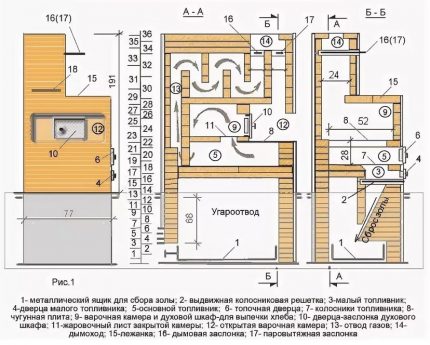
Unique kiln foundation design
The foundation for this version of the stove is also special. Build it as follows. Under the foundation, choose soil at 85 cm. The width of the pit should be convenient for the foundation. The bottom of the mine is covered with sand and tamped so that in the end a layer of sand is 10 cm.
A metal case is installed on a leveled base, in which 4 rows of brickwork are laid on a cement mortar. At a depth of 12 cm to the floor level, waterproofing is laid, from which a carbon drain is constructed: a hollow foundation. This section of the structure is plastered so that cracks can immediately be identified - gas leak points.
This solution allows you to close the chimney view immediately after the furnace, because carbon monoxide will be discharged into the hollow foundation without entering the premises. As a result, the heat engineering performance of the unit is significantly improved. Ash is periodically removed from a metal box pushed out onto the street to collect it.
The channel for the nomination of the ash pan is built of brick simultaneously with the construction of the foundation of the stove. For its formation, metal corners are installed. Bring the channel to the hole made at the same level in the foundation of the house.
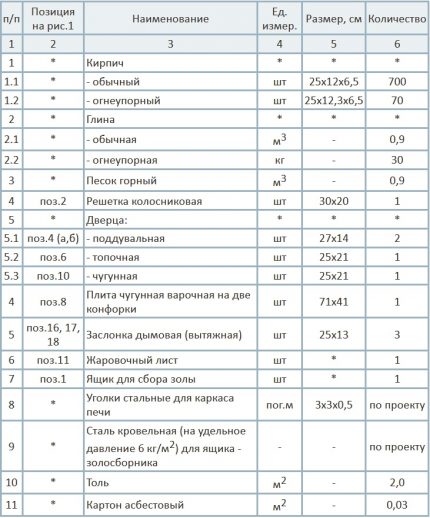
Ordinary masonry in detail
The size of the simplified brick kiln shown in the drawings is 77 × 116 cm in plan, which is equal to 3 bricks wide and 4.5 bricks long. From the floor level, this stove is laid out in a metal frame welded from a corner, or in a solid tin case.
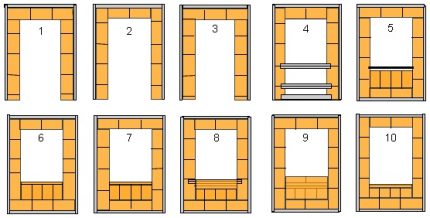
The following diagram shows 10 rows of masonry stoves. After laying the 4th row, a metal corner is installed on its walls, which is required to form the channel. In the 5th row on top of the corners arrange the overlapping channel.
Before laying the 7th row, an asbestos sheet is laid. After laying the 7th row, the formed channel is sheathed with sheet metal.
The construction of the stove from the 5th to the 13th row consists in the construction of a carbon drain. In the 8th row, metal bands are again placed. In the 9th, 11th and 13th row, the brick is placed on the edge.
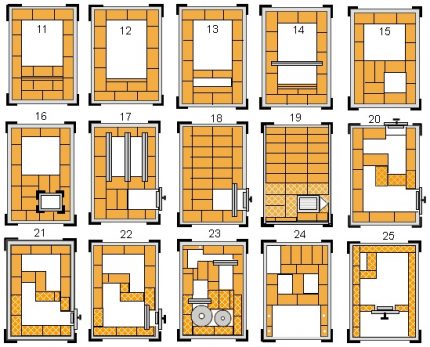
After laying the 14th row, the stove under construction is usually equalized with the floor, although it happens that in order to bring it to the floor level, it is necessary to put another row. The floor around the stove is sheathed with sheet steel.
From the 15th row, i.e. approximately from the field level, the brick structure is again placed in a metal case or frame from a corner. In the 16th, a damper is installed, which is necessary for the removal and collection of ash. The pediment of the stove above this damper will need to be sheathed with metal.
To fix the blower door in the 17th and 18th row, steel strips are laid. In the 18th, the masonry of the overlapping of the exhaust pipe is performed.
In the 19th row, the corners are installed in the masonry, on which the retractable grate will be supported. Through it, ash through the channel will be discharged into a metal box for its collection.
“Under”, the base of the main firebox of the Russian stove, is laid out of heat-resistant brick. In the 20th row of masonry they put a metal frame with a door designed to clean the furnace. Over the 22nd row, metal strips are again laid.
The laying of the 23rd row is carried out by refractory bricks. On the back of the unit, the masonry is made in 3 bricks placed on the edge, and 1/8 of the brick installed flat.
Over the 23rd row, a cast iron stove is fixed, the dimensions of which are 71 × 41 cm. In this row, it is recommended to strengthen with a steel strip. 24 row all put flat.
The masonry from the 25th row is again made of refractory bricks, which are placed on the edge. Now a blind door is installed with dimensions of 25 × 21 cm. It acts as a shutter in a standard Russian oven.
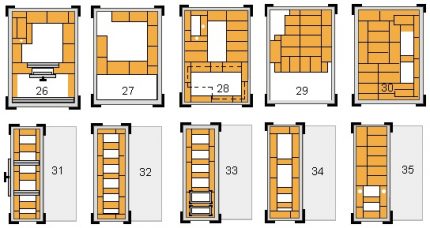
In the left rear corner of the 26th row, the bricks are placed on an edge to form a chimney. All the others in the indicated row are laid flat, and the masonry is reinforced with steel strips. At the bricks mounted flat, they squeeze the inner edge of the lower rib.
At the level of the 26th row, there are metal sheets intended for baking bread. They should fit in the stove 3 pieces, taking into account the gaps between the walls of the unit and these baking sheets.
In length, the middle and right metal sheets are equal to the dimensions of the stove. The left one is shorter exactly on the segment that was formed in the 26th row. So that the left short sheet does not sag, it is fixed in the far corner with a clamp to the middle baking sheet.
In the 27th row, all the brick is laid flat. Before the construction of the 28th row in a compartment designed for baking bread, a stand made of bricks is arranged. The overlap will be based on it.
In the 28th row, the pediment of the stove and the left rear corner, in which the chimney is formed, are laid out of bricks placed on the rib. The front of the unit is reinforced with a steel plate. The rest of the space is filled with bricks laid flat.
Then completely two rows, these are 29 and 30, are built from bricks installed on the edge. In the 31st row, a cleaning hole is formed. As expected, this hole is also reinforced with a steel strip.
At the level of the 33rd row, lintels are laid flat by the bricks between the chimneys. They are lowered half relative to the bricks installed on the edge. In the 34th row have a steam exhaust flap and a view. In this row, reinforcement with a metal strip is again carried out.

In the 35th row, again, all the bricks are placed edge-on when laying the pediment. All other bricks are laid flat. In the 36th and 37th rows, all elements are laid flat. To increase the cross section of the chimney to optimize the movement of gases, around it, at the bricks of the 37th row, the lower inner edge is squeezed.
After they put the pipe, collect it from 5 laid flat bricks. It is connected by dressing with 31 rows. It should turn out so that the 38th row is the penultimate. The 39th row presses a sheet of asbestos to the ceiling. This is an insulating pad.
From the 39th row, the smoke channel is laid by the arranged bricks. To speed up the construction process, it is permissible to use concrete or ceramic blocks.
In arrangement heating stoves traditional metal appliances are used:
Stove appliances are necessary for the proper operation of the unit. With their help, operational ignition of the stove is provided, heat transfer is regulated, technological holes are blocked, and the channels are cleaned of combustion products.
Conclusions and useful video on the topic
A visual demonstration of the brick stove masonry will help you get used to the essence of the process:
It is difficult to call the construction of a brick stove an easy task, but it is quite accessible for independent execution. Guided by the manual and orders presented by us, you can build a perfectly functioning stove with your own hands. Information about the general rules for the construction of heating and cooking units will help to monitor the work of hired stoves.
If you have experience in laying brick ovens, please share it with our readers. Perhaps you know some subtleties that we did not mention in this material? Leave your comments in the communication block, which is located below.

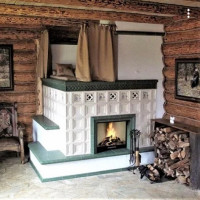 DIY do-it-yourself stoves: construction manuals with diagrams and procedures
DIY do-it-yourself stoves: construction manuals with diagrams and procedures  How to build a Russian stove: do-it-yourself masonry, the best orders and schemes
How to build a Russian stove: do-it-yourself masonry, the best orders and schemes 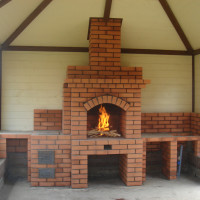 Brick stoves for giving on wood: the best orders and a step-by-step guide to the construction
Brick stoves for giving on wood: the best orders and a step-by-step guide to the construction 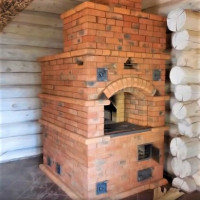 Do-it-yourself mini Russian stove: specifics and arrangements for the construction of a compact stove
Do-it-yourself mini Russian stove: specifics and arrangements for the construction of a compact stove 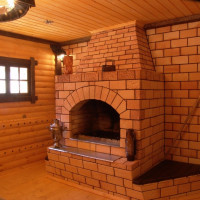 How to stack a stove with a stove: a detailed guide and recommendations for independent stoves
How to stack a stove with a stove: a detailed guide and recommendations for independent stoves 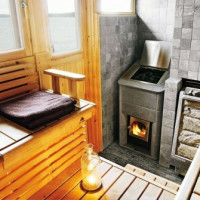 Do-it-yourself gas bath stove: manual for the installation and installation of a gas stove
Do-it-yourself gas bath stove: manual for the installation and installation of a gas stove  How much does it cost to connect gas to a private house: the price of organizing gas supply
How much does it cost to connect gas to a private house: the price of organizing gas supply  The best washing machines with dryer: model rating and customer tips
The best washing machines with dryer: model rating and customer tips  What is the color temperature of light and the nuances of choosing the temperature of the lamps to suit your needs
What is the color temperature of light and the nuances of choosing the temperature of the lamps to suit your needs  Replacement of a geyser in an apartment: replacement paperwork + basic norms and requirements
Replacement of a geyser in an apartment: replacement paperwork + basic norms and requirements
In the old days, a good stove-maker was worth its weight in gold; he was called to lay the stove in all the surrounding villages. Why am I: laying a furnace is a very difficult task. With a lot of nuances and important details. Of course, you can assemble some kind of oven yourself, but will it be good? In my opinion, in such a case it is better to trust a professional who will do everything well. And it is better to look for a person with recommendations, preferably from your friends or relatives.
Shagol, I agree with you, but only partially. Lay out the furnace, if you understand the principles of flue gas circulation, the properties of materials, and so on, you can completely according to the drawing from the Internet. Only it should be remembered that the slightest ledge of the brick or the wrong choice of the consistency of the mortar can be life-threatening during subsequent operation of the device or reduce its temporary operation. But in general, a person with “brains” who has studied the engineering of stove heating can easily lay out the appliance. “Russian stove-makers” from generation to generation, now in the afternoon with fire you will not find. Most masters are self-taught.
I decided to repair the stove in the country house - according to the announcement, 3 stove-makers came, the minimum price for work is 60-70 tr.
It’s better to try it yourself, it may not turn out so beautifully, but I don’t have a cottage or a renovation ...